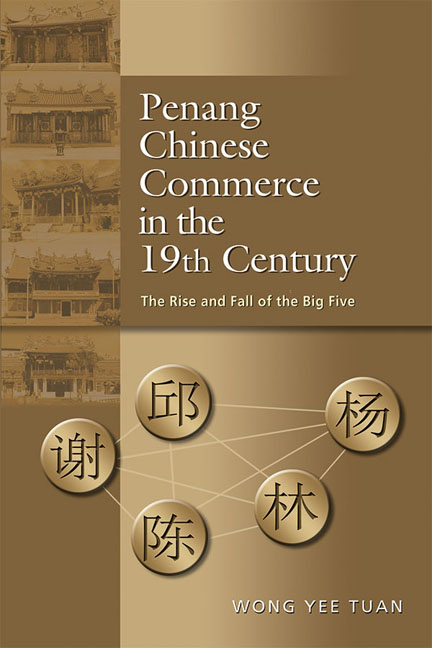Book contents
- Frontmatter
- Dedication
- Contents
- List of Tables, Diagrams and Maps
- Acknowledgements
- Glossary
- Abbreviations and Acronyms
- Notes on Spelling and Names
- Notes on Currencies
- Map
- 1 Introduction
- 2 Penang and the Big Five in Regional Context
- 3 Kith and Kin: The Big Five Familial Web
- 4 Opium Farm Rivalry
- 5 The Contest for ‘White Gold’
- 6 Western Mercantile Elite and Their Challenge to the Penang Chinese
- 7 New Regional Order and the Decline of the Big Five
- 8 Conclusion
- Appendices
- Bibliography
- Index
- About the Author
- Platesection
- Map
2 - Penang and the Big Five in Regional Context
Published online by Cambridge University Press: 19 May 2017
- Frontmatter
- Dedication
- Contents
- List of Tables, Diagrams and Maps
- Acknowledgements
- Glossary
- Abbreviations and Acronyms
- Notes on Spelling and Names
- Notes on Currencies
- Map
- 1 Introduction
- 2 Penang and the Big Five in Regional Context
- 3 Kith and Kin: The Big Five Familial Web
- 4 Opium Farm Rivalry
- 5 The Contest for ‘White Gold’
- 6 Western Mercantile Elite and Their Challenge to the Penang Chinese
- 7 New Regional Order and the Decline of the Big Five
- 8 Conclusion
- Appendices
- Bibliography
- Index
- About the Author
- Platesection
- Map
Summary
Most earlier works have long held that Penang's hey-day finished when Singapore emerged in 1819 at the tip of the Malay Peninsula. This new British colony was strategically situated and able to attract commerce and investment from both the region and the world. Thereafter, Penang was of no real importance, as the rise of Singapore necessarily reduced it to nothing but a local commercial centre. However, this chapter reveals that Penang continued as a flourishing regional hub for the whole of the nineteenth century, and was in some respects even more important than Singapore. It then goes on to discuss the operations of the leading Hokkien merchants, the Big Five, considering their various economic activities from shipping through to entrepot trade, commodity production, opium farming, to coolie trade, and how the Big Five dominated all these economic activities.
The Continuing Prosperity of Penang
The foundation of Penang by the British in 1786 was mainly due to strategic and commercial interests. A series of events in the early 1780s — the active presence of French naval forces in Indian Ocean and their intention to secure the tin trade of the Tenasserim coast during the early 1780s, the closure of Dutch East Indies ports to British ships during 1782–83, and the Dutch conquest of Riau in 1784 — had made the British (East India Company) greatly aware of the dangerous stranglehold two hostile European powers had on their mercantile interests in Southeast Asia. This exigency prompted the British to establish a base in Penang, an island off the west coast of Kedah. Situated at the northern end of the Melaka Straits and on the periphery of the archipelago, Penang was in close proximity to some old trading ports. Aceh in northern Sumatra was nearby in the west, while Kedah and Perak in the western Malay states flanked the east of the island. To the north, it was open to Rangoon and Mergui in southern Burma and Phuket of southwestern Siam, Selangor and Melaka lay to the south. Penang, in the middle of this matrix of ports, developed rapidly as an entrepot. If Penang suffered a decline in trade when Singapore was established in 1819, it quickly rose as a centre of regional trade in the 1820s (Raman 1969/70, pp. 29–30; Freeman 2003, p. 139).
- Type
- Chapter
- Information
- Penang Chinese Commerce in the 19th CenturyThe Rise and Fall of the Big Five, pp. 14 - 46Publisher: ISEAS–Yusof Ishak InstitutePrint publication year: 2015



